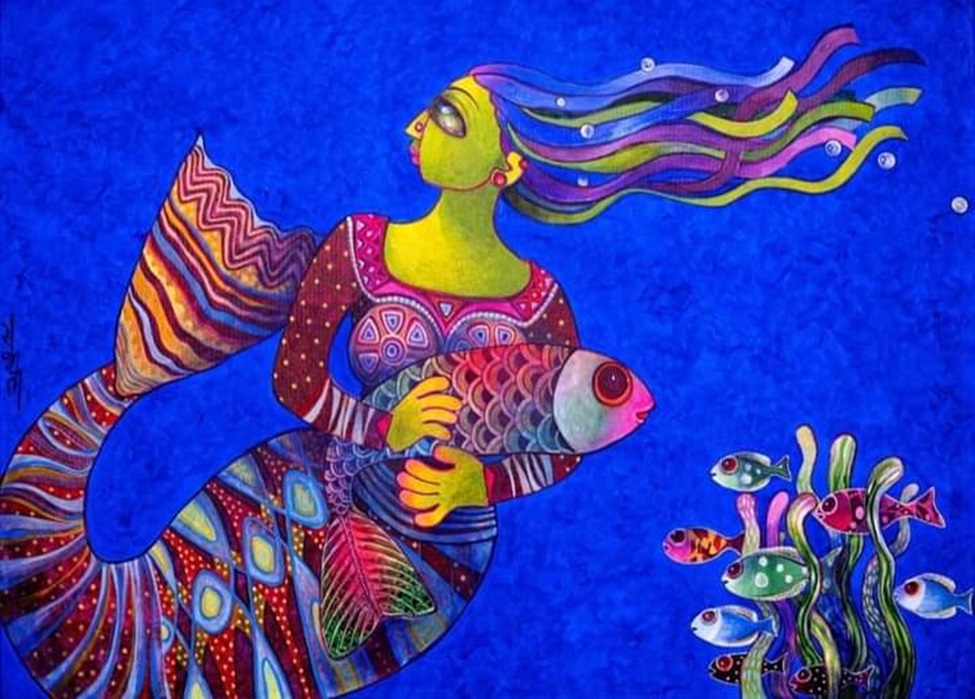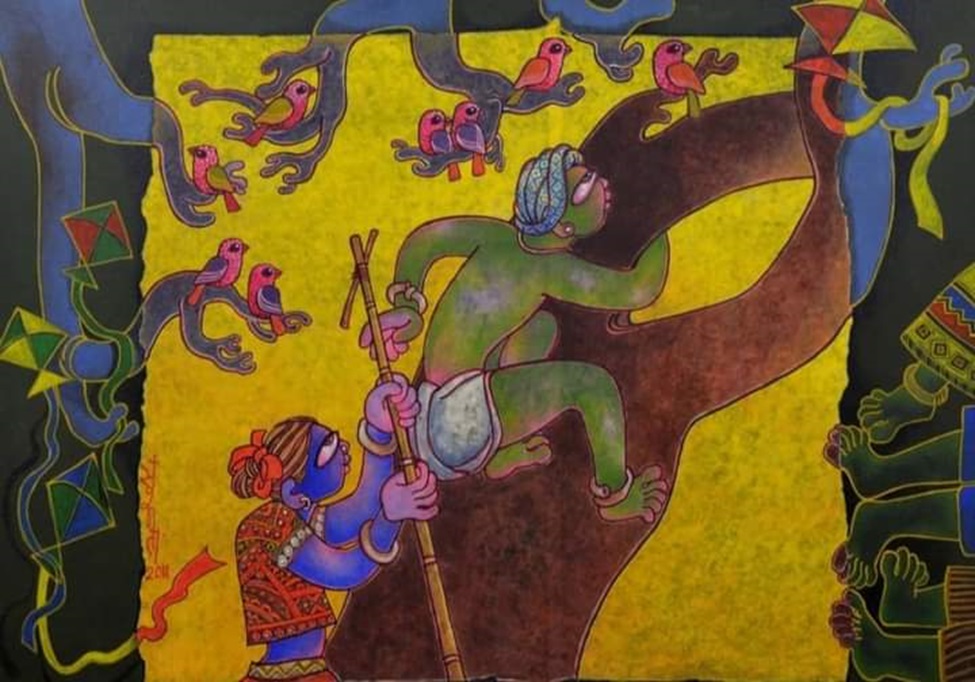Some people express themselves by dancing, some by singing, and some are inclined towards cooking. For me, it’s painting! I express my inner rhythms through my paintings and colours! Sunita Dinda, born in 1971 in Jamshedpur, is a freelance artist. She pursued her Diploma in Fine Arts from Tagore School of Arts & Crafts, Jamshedpur, in 1989 and later pursued a certification course in Decorative Arts & Crafts from the same college in 1995. In 2005, she pursued another degree to enhance her learning and expertise from Rabindra Bharti University, Kolkata, ‘Ankan Bivakar’.
A Child’s Play
I have been inclined towards art and painting for as long as I can remember.
Writing on slates was once an essential educational tool in primary schools. Students would sit cross-legged in classrooms and learn to write alphabets using chalk. These slates were an empty black canvas ready for weird lines and curvy signatures from young, curious minds. Young Sunita often made drawings on those slates more than practising the alphabet. She would do it every day with curiosity and intrigue. Growing up, comic books and magazine illustrations attracted her more than going outside for outdoor plays, and she would copy them in her sketchbook. This was her idea of fun.
Middle-class families in India prioritize financial stability and predictable career paths for their kids. However, when Sunita’s father’s friends came over and appreciated her work, insisting she study art professionally, her family had a change of heart. The young Sunita was overjoyed at the idea of learning what she had been doing just for fun. Like a happy child who discovered a hidden treasure, I found my calling, and I just wanted to pursue a formal education in a field of my choice with all my heart and soul.
The charisma of an Indian woman
In India, women have been integral to culture and society since ancient times. They are not just mentioned in scriptures and holy books as architects of civilization but also play a significant role in preserving and promoting cultural diversity. Female deity worship is considered highly auspicious and sacred, and today, we see modern women evolving through different phases of life, contributing to the rich tapestry of our cultural heritage.
When Sunita had to decide on a protagonist for her paintings, she returned to her roots and embraced her sense of being an Indian woman. From Jamshedpur to Gujarat, she had the opportunity to observe and study the attire, ornaments, and lifestyle of rural and tribal women and their communities. Their physical presence left an imprint on her, which she channelled through her paintings. In her own words, Indian women are beautiful every single day. There’s beauty in their struggle and how they handle their work; their aura and confidence are truly commendable.
Art as expression
The idea of Art as an imitation of the physical environment has been replaced by Art as an expression since the 19th century. Today, Art is an expression that reflects an artist’s inner state: their aura, their impressions, their core and henceforth their gaze. We want to see what we want to see.
Whenever Sunita Dinda is excited about a subject, she completely merges herself into becoming an entity with that subject. In her paintings, she places herself as a creature like a cat or fish, accompanying the protagonist on her quest. Her dreams and imaginations are vivid and bright, and her inquisitive nature keeps formulating possibilities for what-ifs. Her compositions employ bright colours that draw you in when you breathe in a wave of sun and yet do not burn in it. My palette is filled with bright colours but with a tinge of sweetness. I want my visitors to spend time with my work, which is also soothing to their eyes.
A Collector’s Inquiry
An art collector once said, ‘How can one even live without art?’
It was 2004, and Sunita taught at Tagore School of Arts & Crafts in Jamshedpur. Like every other school, an early festivity was organized as a book fair with a painting’s corner. Since Sunita was teaching art in the same school, she displayed her paintings at a booth. A day later, she received a call from the college that someone liked her work and wanted to meet her. She met with the curious lady and found that she was an art collector, and Sunita’s canvases spoke to her. She even visited her home to see more of her work.

The relationship between art collectors and artists is truly unique. When a work captivates a collector, they often seek to understand the artist and their process. They ask questions and seek authenticity; if satisfied, they become loyal patrons. The art collector who discovered Sunita’s works was a buyer and a supporter of her art. She purchased Sunita’s paintings and facilitated more commissions from her network of collector friends, strengthening the bond between them.
It boosted my confidence. It made me think that someone liked my work so much that they were willing to pay for it.
Being an artist is a journey filled with challenges and a test of patience in all phases of life. It can take years to sell even a miniature painting. Some artists start their journey early; for others, it begins later in life, and they may not always reap the benefits. For Sunita, this was her professional artist moment, a testament to the rewards of perseverance and dedication.
An embrace of craft
Is art truly a craft? What is the art of craft? Is there any actual difference between art and craft?
As similar as they may look, art and craft are undeniably two very different concepts. Art is an internal journey of expression towards an idea, whereas craft is using tools to create a specific tangible object.
An art teacher in India is often pushed towards crafts projects as part of the job. Sunita worked with papers and decorative materials for her school during her teaching years. Students would usually ask her to teach during her break periods. Seeing the daily commotion of students around her, a colleague suggested she make videos and upload them online for everyone to access whenever they want. This simple suggestion sparked a new journey for Sunita, leading her to open a YouTube channel and a very active Instagram page with a plethora of creative videos upcoming every day. This transition expanded her reach and brought a new sense of fulfilment and personal growth.
Influence of Indian painters of Bengal School

The Bengal School greatly influenced Indian painting and served as an inspiration to succeeding artistic generations. Some notable artists were Rabindranath Tagore (founder of the Bengal school), Nandlal Bose (first principal of Kala Bhavan) and Kshitindrannath Mazumdar. They broke away from the prevalent Western art styles of the day, primarily focused on realism and individualism and helped establish a distinct Indian art identity. They also opened the way for the creation of modern Indian art.
Sunita found their paintings and thought process inspiring and influential.
I look forward to seeing a sense of Indianness in his works every time. I need to see such eminent artists recognised internationally getting Indian motifs and symbols recognised everywhere.
Montage
Montage is an artist group co-founded by Sunita Dinda and her husband, Santanu Nandan Dinda, in 2005. It is a group of visual artists from the city
of Jamshedpur to further the cause of art, exhibitions and the joy of creating. This group planned four exhibitions and three camps yearly, giving everyone involved an opportunity and hope. In 2006, the TATA group collaborated with the group for an art camp.
What’s next?
In 2008, Sunita and her family moved to Gujarat. In 2018, after two decades of teaching students, she now works as a full-time artist with a YouTube channel. She dedicates her guidance to young kids in need from time to time.

Pallavi Baheti is a creative practitioner from the field of art and curation.





